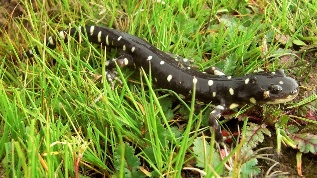Adaptation
Tiger Salamanders have a granular ("poison") gland
concentrated on the upper surface of the tail, and they can
raise and lash their tails if prodded or otherwise threatened. This may discourage some predators. However, many specimen fail
to display any defensive behavior when exposed, except for
trying to walk away or wriggle out of a restraining hand.
This may discourage some predators. However, many specimen fail
to display any defensive behavior when exposed, except for
trying to walk away or wriggle out of a restraining hand.
The Tiger Salamander Sensory System:
Tiger Salamander sense the presence of predators and food
through its sensory system.
The tiger salamander
has a small, compact brain. It has
two cerebral hemispheres comprising its forebrain, which
converge into a midbrain, then
converge into a hindbrain from which the cerebellum and
spinal cord extend. Axons from receptors in the nose
project onto the anterior third of the surface of the
two hemispheres, where the
olfactory bulb, part of the
cerebral cortex, is located; thus, there is a direct
pathway that receptors, with their cilia extending into
the outside world, form by sending their axons directly
into the cerebral cortex. The lateral third of
the
hemispheres contains the pyriform cortex, essentially a
motor cortex with projections going down into the brain
stem with relays into the spinal cord. The medial third
is a well-developed laminated neuropil that we call the
primordial hippocampus. Located between.jpg) these three
areas, is a transitional cortex that receives input by
way of
the thalamus from all sensory systems except the
olfactory (whose input goes directly to cortex in the
manner
described above). Visual, auditory, somatosensory,
gustatory, and olfactory input converges in the cerebral
cortex.
these three
areas, is a transitional cortex that receives input by
way of
the thalamus from all sensory systems except the
olfactory (whose input goes directly to cortex in the
manner
described above). Visual, auditory, somatosensory,
gustatory, and olfactory input converges in the cerebral
cortex.
If you would like to learn about the nutrition of the tiger salamander click here
To go back to habitat click here
If you would like to go back to the home page click here